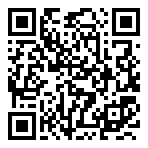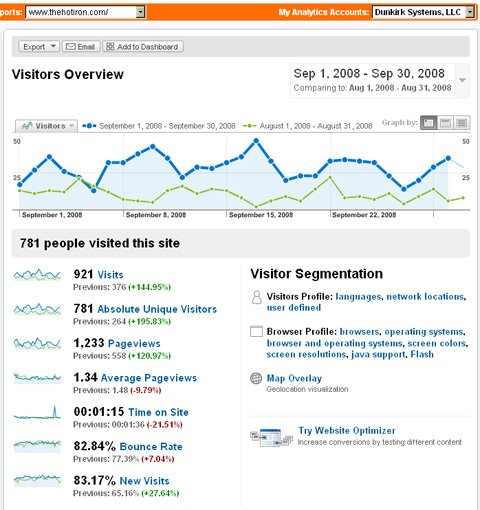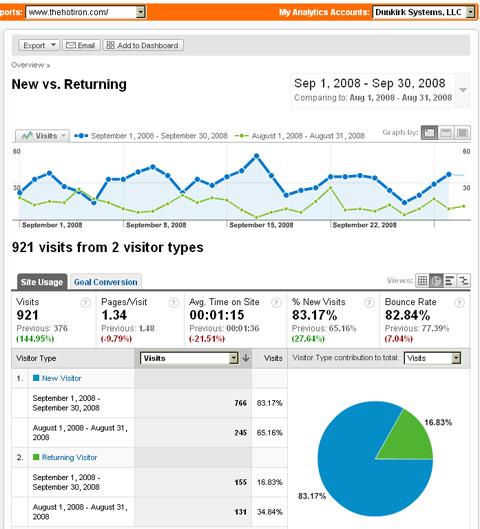Earth Day and QR Codes
 Happy Belated Earth Day 2009! You either scrambled to do something “green” or wondered what more you can do, as it seems you are living about as green of a life as possible. I took a few moments to think about my day-to-day actions and how they impact the big picture of the world, and one word came to mind – innovation.
Happy Belated Earth Day 2009! You either scrambled to do something “green” or wondered what more you can do, as it seems you are living about as green of a life as possible. I took a few moments to think about my day-to-day actions and how they impact the big picture of the world, and one word came to mind – innovation.
The Usual Suspects
As I have previously stated here on The Hot Iron I try to be as aware as possible as to my environmental impact. I wrote what I do in a draft environmental statement for my consulting firm Dunkirk Systems, LLC though I never got any feedback and it still has not reached Dunkirk’s Web site. I also carry a Reisenthel bag with me everywhere I go. Based on these, I feel I am doing as much as I have control over to do.
Other than these actions, making a greater impact takes more work, and that’s where I feel innovation comes into play. When thinking about it more, another thing came to mind – QR codes.
What are QR Codes and Why Should I Care
QR stands for “quick response” and a QR code is a 2-dimensional barcode in the form of a cube. With 2 dimensions, it can store a larger amount of information than a traditional 1-dimensional barcode (e.g. UPC code on a product). As a result, you can store whole sentences of information, Web site URLs, email addresses and even entire contact information records. For example, the accompanying QR code in this post reads, “Happy Earth Day 2009 from The Hot Iron @ thehotiron.com !”
So how would you know that? QR codes are read by a scanner, and the most common form of scanner is a camera on a mobile device with accompanying software. Most Nokia models come preinstalled with a reader, otherwise you can get one from i-nigma among other vendors. Many devices are supported with a notable exception in Palm OS devices.
When the QR code is scanned, the information stored in the QR code is transferred to the mobile device, and you can then process it. If it displays text, you can read and save it. If it’s a URL, you can then browse to it. If an email address, you can send a message to it. If it’s contact information, you can add it to your contacts. This is basic usage of it. With more advanced software, you can do almost anything.
The following is a popular YouTube video from Japan showing how you can get nutritional information for McDonald’s menu items if you can’t see it you can view it here.
Tying The Message Together
As you may guess, QR codes are popular in Asia and in Europe but are still emerging in the US. I see QR codes as an innovative way to effectively communicate and reduce waste and costs at the same time. QR codes only require energy when they are scanned, and by the scanner themselves. They are also more eco-friendly than an RFID tag that require special manufacturing as well as are more cost effective. Here are a few examples of "green" uses that come to mind.
- Subway ads feature a QR code, eliminating the need to have tear-off postcard pads attached to them, or the need to write down information and hard-to-remember URLs.
- For that matter, all advertising should have a QR code with whatever desired call to action the advertiser desires.
- At networking events or conferences, people can wear name badges sporting QR codes with their contact information. This eliminates the need to print and carry business cards, and reduces the time to process information from those cards.
- At the Lollapalooza festival this year in Chicago, replace giving out cards on lanyards with people scanning QR codes to get free songs from iTunes, and they could be downloaded right to your device bypassing the iTunes computer software (with a more robust scanner software).
Where Earth Day continues to be popular, for many it is a day to make symbolic gestures. New, fresh and innovative ideas are needed to reinvigorate it, and QR codes fit the bill. What say you?
Did you enjoy reading this? You are welcome to subscribe to The Hot Iron by RSS feed or by email.
Nokia OpenLab 6 Months Later
It was 6 months ago today that I, along with about 35 others, arrived in Helsinki, Finland for the very first Nokia OpenLab. This 3-day event was a gathering of people from around the world - from musicians to nuclear scientists to photographers to, well, me – who had a passion and interest in how mobile technology can have a positive impact on the future.
If you are a regular reader of The Hot Iron, you will know I have written about OpenLab many times before. It truly was a unique event and I am proud to have attended it. The following video is the official video produced by Nokia of the event, which us attendees first viewed at OpenLab’s conclusion. If you can’t see it in this post you can view the Nokia OpenLab video here.
So what’s happened since? For myself, the biggest change is I have shed my frustration with the Palm brand and am now a loyal Nokia owner, touting the E70 while I determine which model I am going to buy next. The biggest impact for me has been conversations with other attendees. Some are just in passing, following their blogs and tweets. Others I have engaged in more direct conversations, some who I spent a lot of time with when I was there and others who I didn’t, but have made up for it since I left. Even though there were only about 50 people (including Nokia people) it was hard to spend time with everyone. I also had the good fortune to see Steve Lawson and his lovely wife Lobelia when they performed in a house concert in Chicago last December.
In the hectic pace of how our days go, it’s nice to reflect on great experiences. Now back to strategizing and building that future.
Did you enjoy reading this? You are welcome to subscribe to The Hot Iron by RSS feed or by email.
Vindigo Shut Down But Still Out There
 “Now I am wondering what is next to fall.” I asked this question the other day when I wrote of the demise of Yahoo! Briefcase. The next thing I know, I get an email in my inbox from Vindigo. The message, in plain text, stated the following:
“Now I am wondering what is next to fall.” I asked this question the other day when I wrote of the demise of Yahoo! Briefcase. The next thing I know, I get an email in my inbox from Vindigo. The message, in plain text, stated the following:
“Please be advised that Vindigo is no longer in business and your account information on file will not be billed again. We appreciate your past business and apologize that we are no longer able to provide it to you. This email is a service announcement in regard to your Vindigo account and was sent from Vindigo, Inc., 500 Seventh Ave, 17th Floor, New York, NY 10018.”
That’s it – no link, or anything.
For those unfamiliar with it, Vindigo was a service where you could sync content with either a Palm or Windows Mobile device. With that definition and the proliferation of real-time wireless services, you could guess their business model would not last too long. Plus the service was free, so they were not getting any money from me. As I have migrated from my Palm 680 to my Nokia E70, I wasn’t using the service anyway.
Even though there were no links in the email, I attempted to go their Web site at vindigo.com. Even though there was a “404: File Not Found” error message, I noticed the favicon showed up in the browser. This indicated to me the Web site still may be there in some form. So I Googled “vindigo” and it gave links to other pages on the site – including the profile login page – which were still in place and functioning. Removing the home page is one way to take down a Web site, but remember there are other pages people can easily get to.
I am not trying to build a deadpool here on The Hot Iron, only mentioning 2 sites that are shutting down. As things commonly happen in 3’s, dare I wonder who’s next?
Did you enjoy reading this? You are welcome to subscribe to The Hot Iron by RSS feed or by email.
Mobile Device As Seeing Eye
Whenever we talk about usability, computers and their software mostly come to mind. But how about a restaurant menu? Where some may be unorganized or in a different language, to someone who is visually impaired, it may not even appear at all. Rather than having to have someone read it to you, new software for mobile devices can do it for you.
An article appeared in the Boston Sunday Globe featuring such reading software, as well as one of the owners of it, my good friend (and The Hot Iron frequent commenter) Peter Alan Smith. Over the years I have gotten to know Peter as well as his challenges with using technology which most people take its use for granted. I have had the opportunity to help Peter with installing JAWS, a popular screen reading software, onto his Windows notebook, as well as watching him surfing the Web.
Such a device and software break down many barriers. The software was developed by technology futurist Ray Kurzweil and runs on a Nokia N82 mobile device, and can be carried in his pocket as he would carry any phone. Within a minute of taking a picture of text, a computer screen or even currency, he can have the information read to him. Where I have never seen this in action personally, Peter described it in detail that gave me enough to envision it.
I have always said that technology advancements to help those who are given a moniker as “disabled” will have far-reaching uses beyond those people. As I write this post, I am wearing reading glasses that, after 30+ years of looking at computer screens, I now need to have. And at close reach is a wrist strap in the event the mild tingling in my hands that could be early signs of carpel tunnel occurs. Maybe I should pick up a copy of Dragon software to speak future posts, or just podcast them?
Cheers to Peter on this great article for an even greater person!
Did you enjoy reading this? You are welcome to subscribe to The Hot Iron by RSS feed or by email.
Did The Hot Iron Get a Nokia OpenLab Bump?
Did traffic increase to The Hot Iron following my participation in the Nokia OpenLab in Helsinki last month? In general I would hope so, as after meeting many interesting people I started following them online, and I would hope someone would be interested in what I have to say! But the numbers do not lie, and here’s a summary of activity on this little blog.
In this analysis, I used 2 sources. I use Who’s Lookin?, a service by Fiodan Corp., for tracking and reporting daily activity. Every morning I receive an email report of top pages accessed, top referring sites, as well as what networks have visited. This is an excellent indicator of traffic volume and where it is coming from. Watching this report on a daily basis, I saw increased international traffic, and traffic coming from Nokia itself, mostly after OpenLab. These reports gave me a good “gut” feel that I did receive some sort of bump in traffic. For the sake of full disclosure, Dunkirk Systems, LLC a value-added reseller of Who’s Lookin? and am more than glad to talk to you about how this service can help your business!Google Analytics is the other source of data for this analysis. I did a comparison of 2 date ranges – the month of August, 2008 vs. September 2008. As I did my original post on OpenLab on September 1, this would give a good indication of what traffic was like beforehand and after the fact. Below is the chart of Analytics comparing visitors over those periods.

As you can see, there is a definite increase in visits to The Hot Iron, but it did not lead to people spending more time once they arrived. The next analysis I did was on new vs. returning visitors, and here is the Analytics comparison during the same periods.

As you can see, there are many new people, and for those who are new, welcome!
Two other areas I looked at showed no increases – searches and Feedburner subscriptions. OpenLab did not figure into the top search terms that drove traffic to The Hot Iron. Also, there was not a significant change in Feedburner subscriptions. Feedburner does not allow you to analyze traffic beyond 30 days, plus I have always found strange fluctuations in subscriptions on a daily basis that I haven’t considered that a serious traffic stat. I look forward to its further integration into Google, and perhaps into Analytics as well.
In summation, I did receive some bump during the period after OpenLab. If you are one of those who started reading after OpenLab – or not – please feel free to comment as to what brought you here.
Did you enjoy reading this? You are welcome to subscribe to The Hot Iron by RSS feed or by email.

